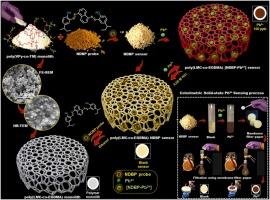Probe-infused polymer monolithic sensor for colorimetric detection of Pb2+ in environmental water samples and tobacco extracts
IF 11.3
1区 环境科学与生态学
Q1 ENGINEERING, ENVIRONMENTAL
引用次数: 0
Abstract
This study focuses on developing an affordable and cost-effective colorimetric solid-state optical sensor for target-specific naked-eye detection of Pb2+, offering significant potential for real-time environmental monitoring and public health applications. The indigenously developed porous polymer monolithic template, poly(lauryl methacrylate-co-ethylene glycol dimethacrylate) (poly(LMC-co-EGDMA) is infused with a chromoionophoric probe, i.e., 6,6-(naphthalene-1,5-diyl bis(diazene-2,1-diyl)bis(4-(butan-2-yl)phenol) (NDBP) to develop a durable/reusable solid sensor. The perforated structural assemblies of the porous poly(LMC-co-EGDMA) are analyzed using a range of microscopic, spectroscopic, and diffraction methods. The template features a homogeneous configuration of interlinked macro/mesoporous networks, allowing for the enhanced integration of NDBP probe molecules to facilitate rapid and improved Pb2+ detection. The fabricated sensor demonstrates a significant solid-state colorimetric shift from pale peach to deep maroon in proportion to Pb2+ concentration, with a precise absorption peak at 543 nm. The operational parameters of the poly(LMC-co-EGDMA)NDBP sensor are optimized to maximize the ion-sensing ability. The sensor demonstrates a linear signal response from 0 to 300 ppb for Pb2+ and corresponding detection and quantification limits of 0.28 and 0.93 ppb, respectively. The sensing effectiveness of the sensor using cigarette samples and natural water samples reveals outstanding accuracy with recovery results of ≥98.9% (RSD ≤1.8%) and ≥99.1%, with RSD of ≤1.7% from quadruplicate analysis. The proposed solid-state sensor offers exceptional sensitivity and selectivity for trace Pb²⁺ detection with a rapid response time of 40 s. The cost-effective and portable sensor provides a valuable tool for environmental monitoring and public health protection by enabling fast, on-site detection of the toxic Pb2+ in contaminated water and tobacco samples, particularly for developing and underdeveloped regions with limited access to sophisticated instruments. Its reusability and accuracy features offer a sustainable and practical solution for addressing widespread lead pollution, thus contributing to safer water quality assessments and pollution control.

环境水样和烟草提取物中Pb2+的探针注入聚合物单片传感器比色检测
本研究的重点是开发一种经济实惠且具有成本效益的比色固态光学传感器,用于针对特定目标的裸眼检测Pb2+,为实时环境监测和公共卫生应用提供了巨大的潜力。将国产多孔聚合物整体模板聚(甲基丙烯酸十二烷基-二甲基乙二醇二甲基丙烯酸酯)(聚(LMC-co-EGDMA)注入亲色探针,即6,6-(萘-1,5-二基二(二氮-2,1-二基)二(4-(丁烷-2-基)苯酚)(NDBP),以开发耐用/可重复使用的固体传感器。采用一系列显微、光谱和衍射方法分析了多孔聚(LMC-co-EGDMA)的穿孔结构组件。该模板具有相互连接的宏观/介孔网络的均匀配置,允许NDBP探针分子的增强集成,以促进快速和改进的Pb2+检测。制备的传感器显示出明显的固态比色变化,从淡桃色到深栗色与Pb2+浓度成正比,在543 nm处有精确的吸收峰。优化了poly(LMC-co-EGDMA)NDBP传感器的工作参数,以最大限度地提高离子传感能力。该传感器对Pb2+具有从0到300 ppb的线性信号响应,相应的检测限和定量限分别为0.28和0.93 ppb。该传感器对卷烟样品和天然水样品的检测精度较高,回收率分别为≥98.9% (RSD≤1.8%)和≥99.1%,四重复分析RSD≤1.7%。所提出的固态传感器对痕量Pb 2 +的检测具有优异的灵敏度和选择性,响应时间为40 s。这种具有成本效益的便携式传感器为环境监测和公众健康保护提供了一种宝贵的工具,能够在受污染的水和烟草样品中快速、现场检测有毒的Pb2+,特别是对于无法获得精密仪器的发展中和不发达地区。它的可重复使用性和准确性为解决广泛的铅污染提供了可持续和实用的解决方案,从而有助于更安全的水质评估和污染控制。
本文章由计算机程序翻译,如有差异,请以英文原文为准。
求助全文
约1分钟内获得全文
求助全文
来源期刊

Journal of Hazardous Materials
工程技术-工程:环境
CiteScore
25.40
自引率
5.90%
发文量
3059
审稿时长
58 days
期刊介绍:
The Journal of Hazardous Materials serves as a global platform for promoting cutting-edge research in the field of Environmental Science and Engineering. Our publication features a wide range of articles, including full-length research papers, review articles, and perspectives, with the aim of enhancing our understanding of the dangers and risks associated with various materials concerning public health and the environment. It is important to note that the term "environmental contaminants" refers specifically to substances that pose hazardous effects through contamination, while excluding those that do not have such impacts on the environment or human health. Moreover, we emphasize the distinction between wastes and hazardous materials in order to provide further clarity on the scope of the journal. We have a keen interest in exploring specific compounds and microbial agents that have adverse effects on the environment.
 求助内容:
求助内容: 应助结果提醒方式:
应助结果提醒方式:


